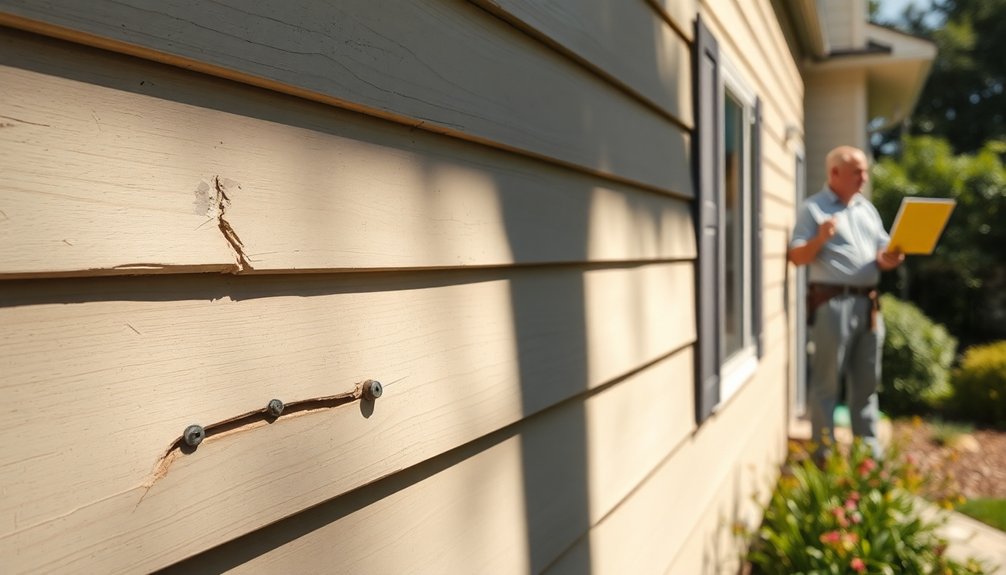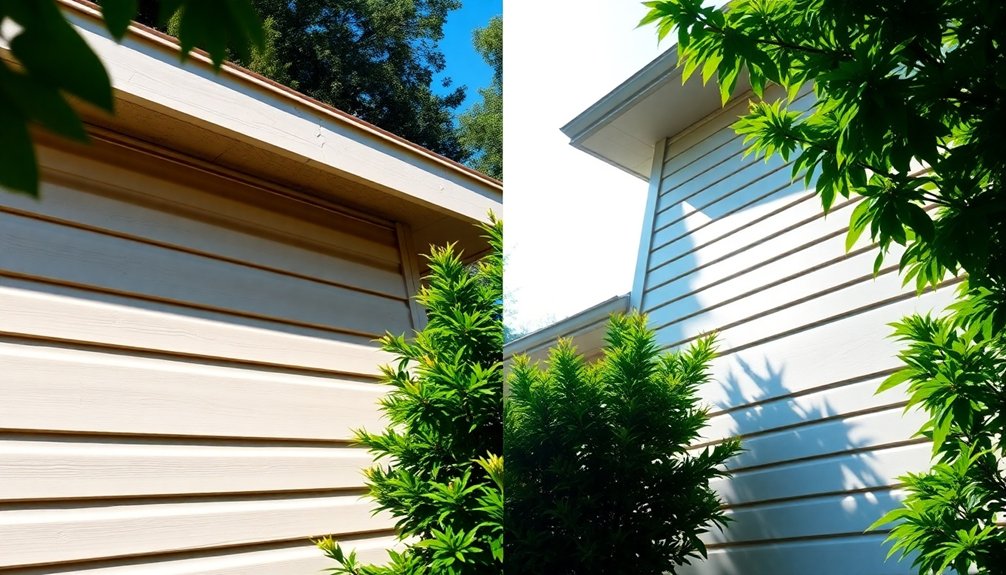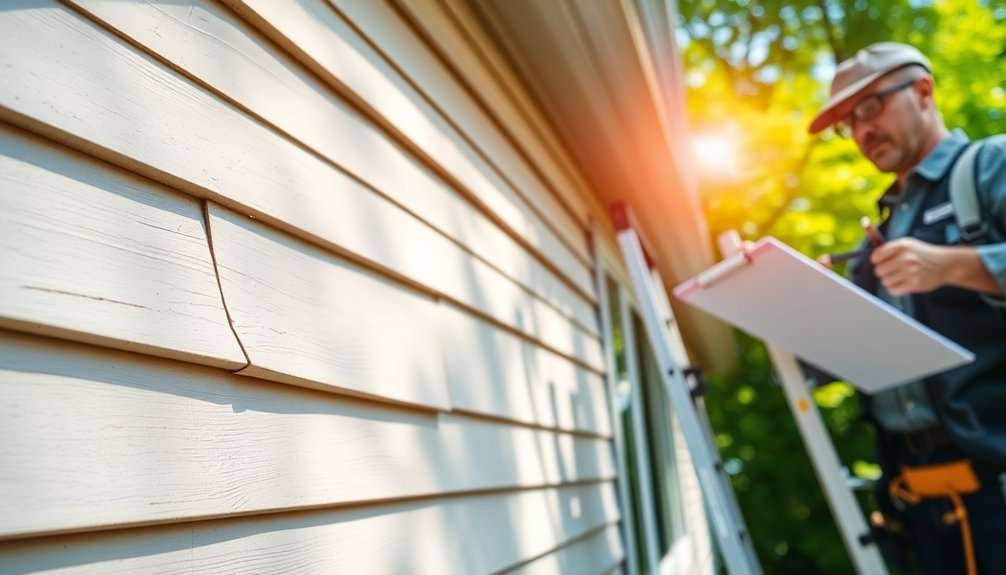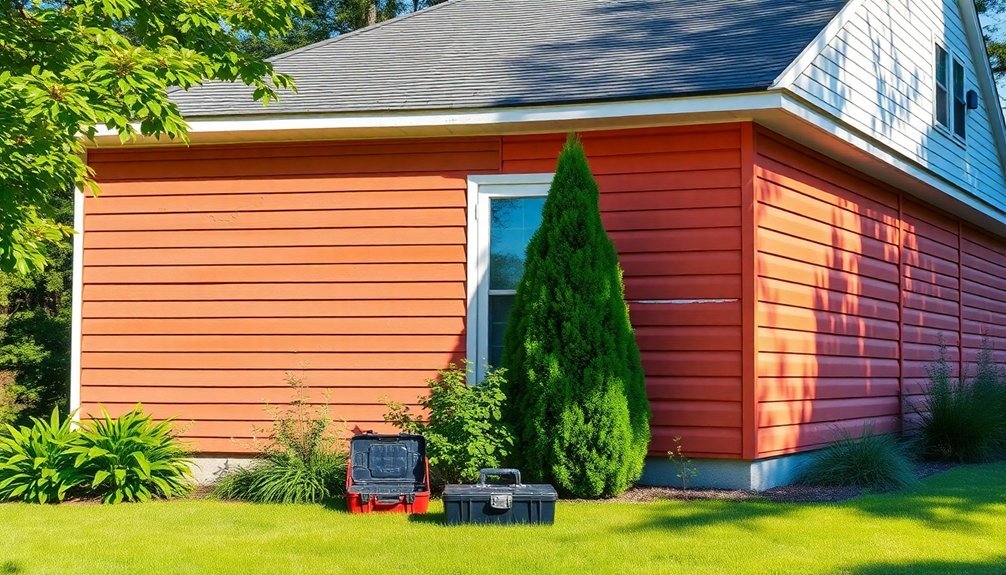Deciding whether to repair or replace your vinyl siding comes down to cost and the extent of damage. Repairs usually cost between $100 to $400 per panel, while replacements can range from $6,000 to $15,000. If you’re facing frequent repairs or the siding is over 20 years old, replacement might be more cost-effective in the long run. Understanding these factors can help you make the best choice for your home, and there’s more to evaluate before deciding.
Understanding Vinyl Siding Repair Costs
When it comes to vinyl siding repair costs, understanding the potential expenses can help you make informed decisions.
Small repairs, like fixing cracks or chips, usually cost between $100 to $400 per panel. For more extensive damage, the average siding repair costs about $2 to $4 per square foot.
Small repairs range from $100 to $400 per panel, while extensive damage averages $2 to $4 per square foot.
Labor rates typically range from $40 to $60 per hour, affecting your total expenses based on the repair’s complexity. Addressing minor damages promptly is vital, as early intervention can prevent higher costs down the line.
If you’re spending around $500 annually on repairs, you might want to reflect on the long-term savings of a full siding replacement instead. Balancing repair or replacement options can save you money in the long run. Additionally, regularly reviewing your financial goals can help you determine the best approach for maintaining your home’s exterior.
Factors Influencing Siding Repair Decisions
When deciding whether to repair or replace your vinyl siding, consider the extent of the damage and the age of your siding.
If you’re facing frequent repairs, it might be more cost-effective to invest in new siding instead. Evaluating these factors can help you make a smart choice that fits your budget and long-term needs. Additionally, using expense tracking tools can help you assess the financial impact of your siding decisions more effectively.
Extent of Damage
The extent of damage to your vinyl siding is a key factor in deciding whether to repair or replace it. Minor issues like small cracks or chips are often manageable, with siding repair costs ranging from $100 to $400 per panel.
If the damage is localized, repairs may be the most cost-effective option. However, widespread damage could indicate that replacement is necessary.
Also, consider that frequent repairs can add up; if your repair expenses exceed $500 annually, you might spend $5,000 over a decade.
Weighing ongoing maintenance needs against potential energy efficiency improvements from newer siding can also influence your decision between repair and replacement.
Ultimately, a thorough assessment will guide your choice.
Age of Siding
Evaluating the age of your vinyl siding is essential in determining whether to repair or replace it. Typically, siding lasts between 20 to 40 years, so if yours is over 20 and shows signs of fading or damage, it might be time to contemplate replacement.
Frequent repairs on aging siding can quickly add up, potentially surpassing the costs of installing new siding. If you notice widespread deterioration, localized repairs may only serve as a temporary fix.
Investing in modern insulated siding can enhance energy efficiency and reduce utility bills, providing long-term savings. Ultimately, evaluating the age of your siding helps you make a practical decision on whether to tackle repair costs or opt for a full replacement.
Long-term Cost Analysis
Deciding whether to repair or replace your vinyl siding hinges on a thorough long-term cost analysis.
Consider these factors in your decision-making process:
- Repair Costs: Frequent small repairs can stack up—spending around $500 annually might exceed $5,000 over a decade.
- Replacement Costs: Full vinyl siding replacement ranges from $6,000 to $15,000, making it more viable for extensive damage.
- Energy Efficiency: New siding can enhance energy efficiency, potentially lowering utility bills and recouping 70% to 80% of costs upon selling.
Ultimately, weigh the long-term costs of siding repair vs. replacement.
Consulting a professional can provide valuable insights into future issues, helping you make an informed decision.
When Is Repairing Vinyl Siding a Good Option?
When dealing with minor issues in your vinyl siding, repairing it can be a smart choice that saves you money and extends its lifespan.
If you notice small cracks, chips, or holes, consider siding repairs rather than a complete replacement. Repairing damaged areas typically costs between $100 and $400 per panel, while full replacement can run you between $6,000 and $15,000.
Addressing minor issues promptly prevents them from escalating into larger problems, which could lead to more costly repairs down the line. Plus, if your siding is relatively new, minor repairs can maintain its appearance and functionality effectively. Additionally, being aware of budgeting tools can help you plan for these repairs and manage your finances more effectively.
Signs That Indicate It’s Time to Replace Siding

If you see visible damage like cracks or warping in your vinyl siding, it might be time for a replacement.
Additionally, if your energy bills are climbing without an obvious reason, your siding may not be insulating effectively anymore.
These signs can help you determine when it’s best to invest in new siding for your home. Moreover, considering conscious consumerism can guide you towards making informed decisions about sustainable siding options.
Visible Damage Indicators
Visible damage to your vinyl siding can signal that it’s time for a replacement rather than a simple repair.
Keep an eye out for these visible damage indicators on your existing siding:
- Cracks, Holes, or Warping: These imperfections can compromise the siding’s effectiveness, making replacement necessary.
- Frequent Repainting or Fading: If you find yourself repainting often, it might indicate that the siding is nearing the end of its lifespan and should be replaced.
- Soft or Rotting Spots: These spots suggest moisture damage, which can lead to structural issues and often warrants a full replacement.
Recognizing these signs early can help you decide whether to repair or replace your siding, ensuring your home stays protected and attractive.
Increased Energy Bills
As energy bills climb, it often signals that your vinyl siding isn’t performing as it should. You might notice a significant spike in your utility costs, sometimes exceeding 20% more than previous months.
This increase usually indicates insufficient insulation or damaged siding, which leads to air leaks and higher heating and cooling expenses. Look for cracks, holes, or warping in your siding; these issues can severely compromise energy efficiency.
Regular inspections can help catch these problems early, potentially saving you from future high energy bills. If your siding is old or damaged, consider replacing it with insulated options.
Doing so can improve energy efficiency and potentially lower your energy costs by 10% to 20% in the long run.
Comparing Costs: Repair vs. Replacement
When it comes to deciding between repairing or replacing vinyl siding, understanding the costs involved is essential.
Here’s a quick comparison:
- Siding Repair Cost: Minor repairs can range from $100 to $400 per panel, but extensive issues may approach the cost of full replacement.
- Full Replacement: This typically costs between $6,000 and $15,000, depending on your home’s size and materials.
- Long-Term Perspective: Spending around $500 annually on repairs totals $5,000 over ten years—potentially more than new siding.
While immediate repairs seem cheaper, newer siding can enhance home value and lower energy bills, making replacement a more economical choice in the long run. Additionally, setting financial goals can help you budget for such significant home improvements more effectively.
Consider both short-term and long-term costs before making your decision.
Long-Term Benefits of Siding Replacement

While you might think of siding replacement as a significant upfront expense, the long-term benefits can far outweigh the initial costs. By investing in new siding, you can recoup 70% to 80% of your costs as increased home value.
Modern materials are designed for durability, which means you’ll likely face lower maintenance costs compared to frequent repairs. Additionally, opting for insulated siding can add $1 to $2 per square foot, providing energy savings that help offset your investment over time.
Ultimately, a full siding replacement not only enhances your home’s appearance but also leads to a more comfortable living environment with reduced utility bills. Investing wisely now can offer significant returns in the years to come. Moreover, utilizing budgeting apps can help you effectively manage your finances to comfortably afford such home improvements.
Energy Efficiency and Its Impact on Siding Choices
Choosing the right siding material can greatly impact your home’s energy efficiency, especially when considering options like insulated vinyl siding.
Here are three reasons to prioritize energy-efficient siding materials:
- Better Insulation: New siding materials offer improved insulation, which can lead to lower utility bills compared to older, uninsulated options.
- Long-Term Savings: Investing an extra $1 to $2 per square foot for insulated siding can result in significant savings on heating and cooling costs over time.
- Increased Home Value: Replacing aging siding with energy-efficient materials can recoup 70% to 80% of your investment, making it a smart financial choice. Additionally, utilizing investment tracking tools can help you monitor the cost-benefit of such home improvements.
Choosing the Right Contractor for Siding Work

Finding the right contractor for your vinyl siding project is vital to achieving a durable and aesthetically pleasing result.
Start by seeking a siding contractor with significant experience specifically in vinyl projects. Verify their licenses and insurance to protect yourself during the work.
It’s important to choose someone familiar with local climate conditions; this guarantees they recommend the best materials and techniques suited for your area.
Check for positive customer reviews to gauge reliability and service quality.
Finally, obtain written estimates from multiple contractors to compare initial costs and services offered. This will help you make an informed choice, whether you need to repair siding or undertake a complete replacement. Additionally, ensure the contractor understands the importance of expense categorization, as it can aid in budgeting for your project effectively.
Making an Informed Decision: Repair or Replace?
When faced with the decision to repair or replace your vinyl siding, how do you know which option makes the most sense? Consider these factors:
- Cost of Frequent Repairs: If your annual repair costs exceed $500, you could be looking at $5,000 over ten years. This suggests that frequent repairs may not be the best investment.
- Age of Siding: If your siding is old and nearing the end of its lifespan, a full replacement might enhance durability and save you money in the long run.
- Consult a Professional: Get insights from a siding expert who can evaluate the damage and help you weigh repair versus replacement options effectively. Utilize bill tracking apps to keep your finances in check while making this important decision.
Conclusion
Ultimately, deciding whether to repair or replace your vinyl siding hinges on cost, condition, and long-term benefits. While repairs can be a quick fix, they might not always be the most economical choice in the long run. Studies show that replacing old siding can enhance energy efficiency and boost your home’s value. Weigh your options carefully, consider your budget, and consult a professional to guarantee you make the best decision for your home’s future.



